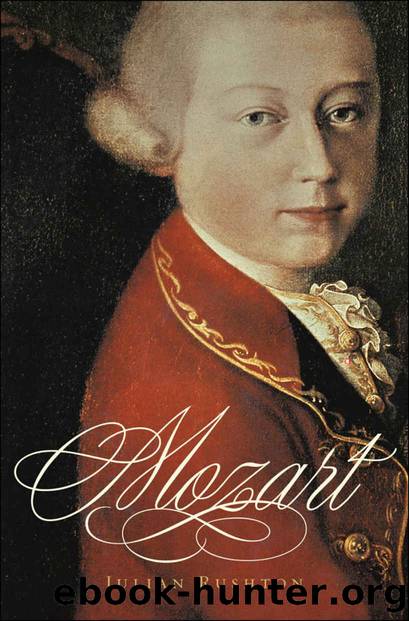Mozart by Rushton Julian

Author:Rushton, Julian
Language: eng
Format: epub
Publisher: Oxford University Press
Published: 2006-01-31T16:00:00+00:00
The last symphonies
The most remarkable event of 1788 is the rapid completion in June, July, and August of what proved to be Mozart’s last three symphonies, in E♭ (K.543), G minor (K.550), and C (K.551, the ‘Jupiter’). Although the most obvious intention in writing such pieces was to supply works for performance, they may have been partly inspired by the recent publication of Haydn’s ‘Paris’ symphonies, three of them in the same keys.20 If so, as with the ‘Haydn’ quartets, the spirit of emulation, rather than of imitation, was what drove Mozart. It is only in retrospect that the symphonies appear as a triptych designed to show that Mozart, guided by his musical ambitions, could reshape the expectations of a genre familiar to all his audiences.
The slightly earlier ‘Prague’ symphony has Mozart’s grandest slow introduction, but K.543 runs it close. The ‘Prague’ uses a motif for the ceremonial call to attention that reappears to open the allegro of K.551. In the ‘Prague’, majestic gestures related to the old-style French overture are dissolved by a passage of harmonic mystery in ‘ombra’ (shadow) vein. The playfulness and sinister undertones of Don Giovanni are not far away; the syncopations of the allegro are not those of Sturm und Drang but of anticipation, and shadows cast before the elegant lead-in to the flowing secondary theme, and within the slow movement, serve to brighten the sunshine.
K.543 is Mozart’s only symphony to displace oboes in favour of clarinets, effecting the sound-world as they do in the two piano concertos with this orchestration (K.482 and 488). The introduction is only overclouded in the last four bars before an allegro that jovially sublimates the early waltz, or Ländler. The emotional centre of this symphony is the slow movement, in A♭, based on the Romanza pattern: an innocentsounding theme and a stormy episode which, through a piece of enharmonic wizardry, appears first in F minor, then in its polar opposite, B minor (compare bars 30 and 96). The lilting quality of the slow movement of the ‘Prague’ may compensate for the absence of a minuet, which in K.543 seems faster, and less stately, than usual. The nerviness of the ‘Prague’ finale comes from its syncopated theme, and a certain brittleness in harmony (frequent recourse to minor inflections) and texture, notably the tiny passages for the woodwind groups. The contredanse finale of K.543, like that of the later quintet K.614, vies with Haydn for musical wit. The only theme of any importance is a seven-note motif, put through every harmonic and instrumental pace in music as intellectually stimulating as it is entertaining.
If the ‘Prague’ and K.543 have much in common, the G-minor and C-major (‘Jupiter’) symphonies confirm Mozart’s ability to deliver twins of opposite character, like the string quintets in the same keys; and also to confirm the danger of reading autobiography in the character of his music. These last two symphonies have been the subject of more intense scrutiny than any of Mozart’s instrumental works.21 Neither has any introduction,
Download
This site does not store any files on its server. We only index and link to content provided by other sites. Please contact the content providers to delete copyright contents if any and email us, we'll remove relevant links or contents immediately.
| Classical | Country & Folk |
| Heavy Metal | Jazz |
| Pop | Punk |
| Rap & Hip-Hop | Rhythm & Blues |
| Rock |
Cecilia; Or, Memoirs of an Heiress — Volume 3 by Fanny Burney(30934)
Cecilia; Or, Memoirs of an Heiress — Volume 2 by Fanny Burney(30889)
Fanny Burney by Claire Harman(25784)
We're Going to Need More Wine by Gabrielle Union(18072)
Plagued by Fire by Paul Hendrickson(16636)
Cat's cradle by Kurt Vonnegut(13866)
Bombshells: Glamour Girls of a Lifetime by Sullivan Steve(13108)
All the Missing Girls by Megan Miranda(12747)
Leonardo da Vinci by Walter Isaacson(11901)
4 3 2 1: A Novel by Paul Auster(11047)
Adultolescence by Gabbie Hanna(8145)
The remains of the day by Kazuo Ishiguro(7551)
Note to Self by Connor Franta(7024)
Diary of a Player by Brad Paisley(6866)
Giovanni's Room by James Baldwin(5877)
What Does This Button Do? by Bruce Dickinson(5527)
Recovery by Russell Brand(4564)
Born a Crime by Trevor Noah(4510)
The Kite Runner by Khaled Hosseini(4432)
